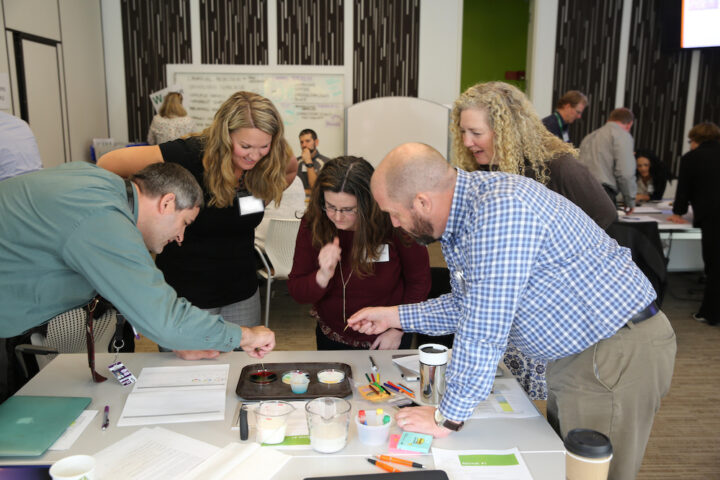Principals! Here’s what you can do to foster equitable three-dimensional science learning

- Teachers should provide principals with resources such as this tool and this other resource to explore how best to support 3D science learning.
- District Staff & PD Providers should dedicate time for content-specific professional development for principals, to enable them to lead the implementation of science instructional change in their buildings.
- School Leaders should Increase their knowledge of 3D science learning and develop strategies to effectively lead the implementation of these changes in science instruction across their buildings—on their own & with others.
What is the Issue?
Principals directly influence classroom instruction, second only to teachers in impact on student achievement. However, school principals have varied content and pedagogical backgrounds and few have had learning experiences engaging in the practices of scientists and engineers to explain phenomena and solve challenging problems. Without these experiences, too few principals are effectively leading for improvement of equitable science instruction. This tool describes some steps that districts and/or individual principals can take to enable them to effectively lead the implementation of three-dimensional (3D) science learning in their schools.
Image courtesy of the Institute for Systems Biology (ISB), isbscience.org
Authors:
By Tiffany Clark, Jennifer Eklund, Caroline Kiehle, Kim Klinke & Richard Sander | February 2022
Reflection Questions
- As an instructional leader, what roles do you play in implementing equitable 3D science learning?
- How prepared are you to lead implementation of 3D science learning in your school?
- How could science learning walks help increase your knowledge of 3D science learning? How would you approach engaging in them?
Things to Consider
- Three-dimensional (3D) science learning should look and sound different than learning in traditional science classrooms. Instructional leaders need experiences that help them learn to recognize effective 3D science learning.
- When principals participate in 3D science learning activities as part of their professional development process, they experience what it is like to be a learner with these new science standards, thus deepening their ability to recognize 3D science learning during brief learning walks.
- Principals using this science learning walk recording tool in their school buildings gain insights into 3D science learning. Listening to student discourse and looking for evidence of student learning across the three dimensions should be key areas of focus for successful learning walks. Instructional leadership teams may also want to explore this procedure for specifically learning to notice the science and engineering practices.
- With an established understanding of 3D science learning, principals can identify their problems of practice and develop action plans that address specific needs related to their school’s science instruction. Five key actions to build into these plans are called for in the The Wallace Foundation report The School Principal as Leader: Guiding Schools to Better Teaching and Learning. Principals can use these case stories and reflection questions, tied to these 5 key actions, to guide their own thinking for professional learning in science leadership.
- School principals and leaders should participate in professional learning communities—including teacher learning communities. This provides a space to share ideas, questions, and challenges that develop from a deep focus on the specific discipline of science and to understand how to translate new insights to other disciplines or integrated approaches.
- One way to gain a better understanding of the three dimensions and why each of them are important for learners is through facilitated interactions with professional scientists and engineers who can help illuminate the skills and knowledge that promote student success through varied educational and career pathways.
Attending to Equity
- The NRC Framework calls for each student to be be provided with opportunities to learn and engage in science and engineering, resources and teachers that support and motivate learning, and adequate time for science learning. Principals are key gatekeepers at every aspect of this vision and therefore play an essential role in answering this call. Their deeper understanding of 3D science learning allows them to set culture, shift policy, direct resources, and lead for quality 3D science instruction in more informed and purposeful ways. When principals take an active role as instructional leaders for 3D science learning, their vision for student learning within and across the disciplines changes the experience and opportunities in their school.
Recommended Actions You Can Take
- Personal learning: Gain awareness and insights about the vision of 3D science learning by exploring the Framework.
- Professional learning with other principals: Gather evidence from your own school to learn more about 3D science learning by going on individual or team learning walks to learn to recognize 1, 2, or all 3 dimensions during science lessons. Calibrate the evidence you collect with colleagues from other schools.
- Leadership actions: Go on frequent learning walks through your building. This will place a student-focused lens on the learning activities, to help you develop your own action plan to support all science teachers’ professional learning. Continue to work on all 5 key actions of effective principals to initiate, encourage, and enhance 3D science instruction and learning.
- Learn more about the principal’s role to influence classroom instruction through the Principles of Science for Principals developed by the Logan Center for Education at ISB.
ALSO SEE STEM TEACHING TOOLS
- #3 Cascade of Practices
- #9 Focusing PD
- #21 Administrators & 3D Sci
- #51 District Implementation
- Playlist Principals & 3D Sci
STEM Teaching Tools content copyright 2014-22 UW Institute for Science + Math Education. All rights reserved.
This site is primarily funded by the National Science Foundation (NSF) through Award #1920249 (previously through Awards #1238253 and #1854059). Opinions expressed are not those of any funding agency.
Work is licensed under a Creative Commons Attribution-ShareAlike 4.0 Unported License. Others may adapt with attribution. Funded by the National Science Foundation (NSF). Opinions expressed are not those of any funding agency.


 Email Feedback
Email Feedback


